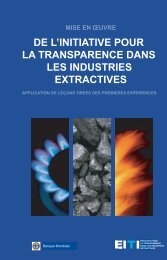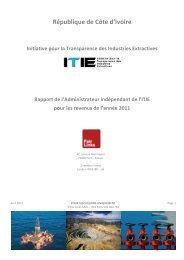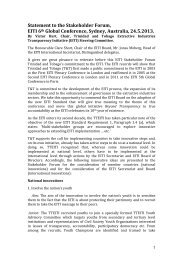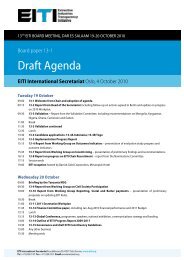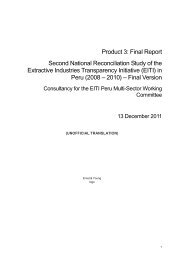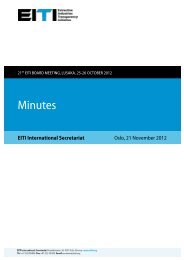Vietnam feasibility study - EITI
Vietnam feasibility study - EITI
Vietnam feasibility study - EITI
Create successful ePaper yourself
Turn your PDF publications into a flip-book with our unique Google optimized e-Paper software.
22<br />
I.4 General cOmmenT<br />
<strong>Vietnam</strong> is diverse and it has potential for more mineral resource development with 60 types of<br />
minerals, especially as survey and exploration activities has just been carried out over half of the<br />
country. However, with the current proven reserves, mineral resources are quite limited. Almost all<br />
deposits are fragmented with a minimal reserve and in difficult conditions for exploitation. Some high<br />
value minerals such as gold, silver and nickel have tiny reserves. Some have been exploited for a long<br />
time, such as oil and coal, and will soon be unable to satisfy domestic demand. On one hand, some<br />
of <strong>Vietnam</strong>’s large mineral reserves, such as titanium and bauxite, are very common throughout the<br />
world and, therefore, demand is not high. Therefore, <strong>Vietnam</strong> should reorient its mineral development<br />
strategy, in which mineral resource should be sustainably managed and developed. The benefits of<br />
mineral resources must be maximized, and revenue generated from the EI sector should be wisely<br />
used for the development of the nation.<br />
Recently, the extractive industry has played a crucial role in the economy, increasing its contribution<br />
to the state budget and socio-economic development throughout the years. Its contribution accounts<br />
for 9.6-10.59% of the GDP from 2000 to date. In 2009, export of crude oil reached 8.5 billion USD,<br />
accounting for about 25% of state budget. In fact, the total investment of the extractive industry<br />
attains a high ratio compared to other economic sectors. However, its efficiency contributing to the<br />
GDP and job creation is not commensurate with the investment capital.<br />
Generally speaking, most large scale and important mines are currently managed and exploited<br />
by the state owned enterprises. The participation of foreign invested enterprises in the extractive<br />
industry is still limited. Meanwhile, the private sector often operates at a small and medium scale.<br />
Hence, this group has been facing much difficulty about human resources and capital, so that it often<br />
uses backwards technology in exploiting and processing minerals, resulting in a waste of mineral<br />
resources. The situation of so called “avoid the difficult and do the easy” and unplanned exploitation<br />
tends to reduce productivity, though it remains quite popular in the extractive industry.<br />
So far, the EI sector has not been well managed and developed and has exposed many problems and<br />
inadequacies resulting in seriously adverse impacts to the environment and the society. Accounting<br />
for these, <strong>Vietnam</strong> still highly focused on economic development, especially GDP growth, to satisfy its<br />
current demand. In addition, mineral resources are poorly managed due to the lack of oversight from<br />
state management agencies and the people. The role of the people, especially local communities,<br />
is weak in monitoring, evaluating and policy-making. Consequently, mineral resources have been<br />
publicly smuggled in many areas for years. Tax evasion, the so-called “beg and give” 2 mechanisms<br />
in licensing occurs commonly. Therefore, the nation has not only lost huge revenues, but also critical<br />
resources for boosting up the economy in the future when these resources are exhausted while<br />
demand on minerals for economic development is still high.<br />
*2: “Beg and give” means that the institutional system still works collectively where company often get the license based on its<br />
relationship rather than the technological and financial ability.<br />
The Extractive Industries Transparency Initiative and the Implementation Perspective of <strong>Vietnam</strong>




